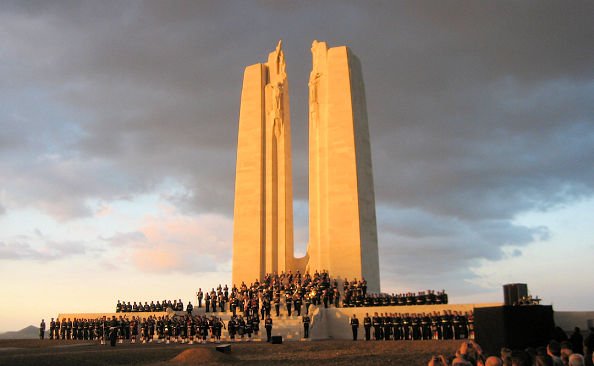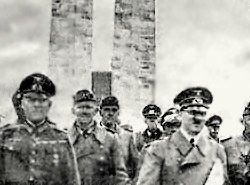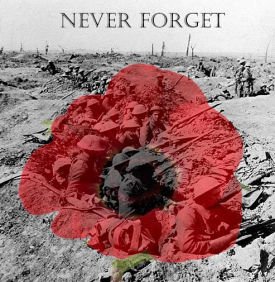Northeast of Arras, France an escarpment rises from the Douai Plains reaching a point some 60 metres (200 ft) above it. It’s runs a distance of 7kms. From the west, the rise is gradual, from the east it’s a steep incline. From its highest point a commanding view of tens of kilometers is unobstructed in all directions.

Source
Vimy Ridge in WW1
It’s no surprise that during WW1 this ridge became a hotly contested piece of ground. The Germans captured the ridge in 1914. They steadily fortified the ridge with zigzagging trenches, anchored with concrete pill boxes housing MG-08 machine guns. The artillery and mortar teams stationed on the ridge had mapped out the areas of advance. Their fire was deadly for any advancing on the ridge.
Between 1914 and 1915 the French had tried to retake the ridge three times and failed each time. Over 300,000 troops were lost in the attempts. The British moved into the area and were also unable to dislodge the Germans.
Canadian Corps Ordered to Vimy Ridge
The Canadian Corps was ordered into the area in October 1916. The Corps was 100,000 strong consisting of four infantry divisions, twelve battalions, machine gun units, artillery, engineers, labour battalions, medical units and other support units.
Canada at the Start of WW1
When Canada went to war along with Britain in 1914 it had a population of eight million and a standing army of 3100 with a small fledgling navy. Over 600,000 Canadians would answer the call to arms. This forced the government to scale up the training and equipping of a military rapidly.
The first Canadian division went into combat in March 1915 at Neuve Chapelle, France. Canadians participated in the 2nd Battle of Ypres and the Battle of the Somme. They developed a formidable reputation for their ability to take their objectives, becoming the shock troops for much of the rest of the war.
Not yet an independent nation, the Canadian Corps served within and under British command. Canadian leaders applied pressure for the Canadian corps to fight together. All four divisions were sent to Vimy under the command of British Commander Sir Julian Byng who would later become the Governor-General of Canada.
Canadian Corps Prepares for Battle
The Canadians prepared extensively for the battle to retake the ridge. They studied what had worked and hadn’t worked in previous attempts as well as other battles. They decided on their plan and proceeded to prepare. The work was massive, building supply routes, trenching and tunnels pushing under no mans land.
They trained behind the lines for the battle to come. About three months before the battle they started carrying out a series of raids testing and probing the German defenses. The Germans learned to fear the Canadians.

Source
Starting in late March the Allies started bombarding German defenses. They stepped up the intensity on April 2nd. New fuses on the bombs meant they exploded on contact rather than after burying in the ground. Their killing power intensified. In all, over one million shells were lobbed at the German defenses.
The tunnels under no mans land brought the attacking Canadians closer to the enemy without the vulnerability of scrambling over trench tops to start their advance.
The Battle of Vimy Ridge
The attack commenced at 5:30am on Easter Monday, April 9, 1917. Artillery started the attack with what would be a creeping barrage. Medium and heavy artillery established standing barrages closer to the Germans while lighter artillery moved their barrages forward at a rate of about 100 yards every 3 minutes thus creating some cover fire for the advancing troops.

Source
Canadian troops blew out the ends of tunnels and scrambled up over trench tops to begin the advance. As they advanced and overran German positions the captured Germans quickly realized the best way to stay alive in the face of the advancing Canadians was by making themselves useful. Hundreds of German prisoners volunteered to carry the wounded from the battlefield.
By the end of day on April 10th much of the ridge had been captured, including the highest point, Hill 145. The cost was the largest single day loss of Canadian troops in our history. During those two days 7,700 Canadians were killed or wounded.
It would take another two days for the ridge to be fully secured by the evening of April 12th. The four day battle came at a cost of 10,602 casualties, 3,598 battlefield deaths and an unknown number who died of wounds later. Over 4,000 German prisoners were taken.
This video, narrated by William Shatner, describes the battle.

The Germans never tried to retake the ridge. Four Victoria Crosses, the Commonwealths highest award for valour, were awarded. Three of those were posthumously. Hundreds of other gallantry awards were awarded as the result of the battle.
I once came across an anecdote that after the fall of Vimy Ridge a Frenchman ran into a cafe in Givenchy and announced that the ridge had been taken. “Impossible” he was told. “It was the Canadians” the man insisted. “Ah, c’est possible” the patrons conceded.
The Meaning to Canada
The Canadians had done what had seemed to be the impossible. For the men who survived the battle there was an incredible sense of relief that they had marched into the face of death and survived. Many who wrote home afterwards spoke of the sights of death and destruction that were beyond imagination.
In the intervening 100 years, various historians have argued about the importance of the Battle of Vimy Ridge. Some believe it was our coming of age as a nation. Others that it was a significant victory but not our greatest victory.
If nothing else, the battle established another of many steps our nation took toward breaking the ties with Britain and being seen as a sovereign nation in our own right. While our neighbours to the south fought a bloody war of independence, Canada developed into an independent nation.
The Vimy Ridge Memorial
After the war, France ceded Canada 250 acres of the ridge in perpetuity, including Hill 145, to establish a battlefield park and memorial. A commission was established to receive and decide on designs for the memorial. They selected the design by Toronto sculpture Walter Seymour Allward.

Source
Allward established a base in Europe and began the process of building the monument. After an extensive search, he decided on the use of Seget limestone which had to be brought from Croatia. The limestone aged better than any other he’d found.
The monument took eleven years to build. Engraved on the monument are the names of the Canadians killed or missing during the war with no known graves.
In 1936 King Edward VIII unveiled the monument before a gathered assembly of over 50,000 including 6,000 veterans of the battle that claimed the ridge. The unveiling was one of the few official acts King Edward carried out before his abdication.

Restoration and Rededication for the 90th Anniversary
After WW2 interest in the memorial fell off. Sufficient funds to maintain the monument and the site were not provided. In 2001 the government established a $30million fund to restore the monument.
On Easter Sunday, April 9, 2007 as part of a ceremony to mark the 90th anniversary of the Battle of Vimy Ridge, Her Majesty Queen Elizabeth II, Queen of Canada, rededicated the restored memorial. It was estimated the crowd on the site that day was the largest since it had been dedicated in 1936.
At a dinner later that day, then Prime Minister Stephen Harper shocked the assembled with the announcement that six Canadian soldiers had been killed by a roadside bomb in Kandahar province, Afghanistan. The largest single day loss of life for Canadian soldiers fighting in Afghanistan.
The more history changes, the more it stays the same.
One Hundred Years Later
The hundredth anniversary will be marked with ceremonies at the Vimy Memorial in France and with hundreds of parades and services across Canada.
Givenchy, a town near the ridge which was occupied and destroyed by the Germans has rolled out the welcome mat for the Canadians they have never forgotten in the intervening century.

Age shall not weary them, nor the years condemn
At the going down of the sun, and in the morning
We Will Remember them.

——————————
Still Pending Posts
I hope you enjoyed reading my post. Below are the posts still pending payout as of the time of the writing. I invite you to visit the posts and upvote them if you like them:
Happy Birthday Dad, Where Ever You May Be — payout Apr. 10th
Paragraphs People! Use Paragraphs — payout Apr. 11th
Steemit Ramble #89 — payout Apr. 11th







If you like this, please follow me and upvote the post.
If you’d like to see the other days I’ve posted, just visit my profile
If you’d like to be notified when I post next, join my mailing list here.
If you’d like to join my curation trail on Streemian, please click here
Mine STEEM on Eobot Click Here

